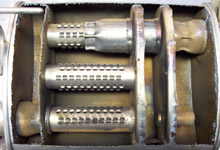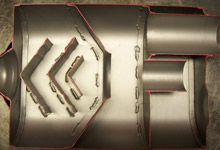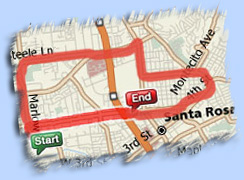|

 It's
getting harder to be a successful aftermarket exhaust company.
The days of selling on the promise of horsepower may be nearing
an end. Exhaust companies are now facing tough competition
from an unlikely source - the automakers. As companies like
Ford strive to increase fuel economy they are making significant
changes in engine technology and efficiency. With advancements
such as variable valve timing and high efficiency cylinder
heads, the combustion chambers don't need nearly as much scavenging
- the effect of the exhaust creating negative pressure to
draw out spent combustion gasses from the cylinder. Scavenging
was something exhaust companies leveraged to achieve their
power claims. To add salt to the wounds, the aftermarket mufflers
often increase drone to levels unacceptable to the owner.
This has become particularly true as more and more new vehicles
come with mufflers mounted right behind the rear bumper, with
no discernible tailpipe length to reduce the frequencies that
cause drone. It's
getting harder to be a successful aftermarket exhaust company.
The days of selling on the promise of horsepower may be nearing
an end. Exhaust companies are now facing tough competition
from an unlikely source - the automakers. As companies like
Ford strive to increase fuel economy they are making significant
changes in engine technology and efficiency. With advancements
such as variable valve timing and high efficiency cylinder
heads, the combustion chambers don't need nearly as much scavenging
- the effect of the exhaust creating negative pressure to
draw out spent combustion gasses from the cylinder. Scavenging
was something exhaust companies leveraged to achieve their
power claims. To add salt to the wounds, the aftermarket mufflers
often increase drone to levels unacceptable to the owner.
This has become particularly true as more and more new vehicles
come with mufflers mounted right behind the rear bumper, with
no discernible tailpipe length to reduce the frequencies that
cause drone.
Kevin McLelland, Research Manager at Flowmaster Mufflers,
identified this threat long ago, and has been shouting it
from the proverbial rooftops at Flowmaster ever since. "Until
recently the formula was simple. However with new cars it
is very tough to differentiate your product. We don't want
to be in a position where we are selling on sound alone, because
that is what every exhaust company does." That is a remarkable
statement coming from Flowmaster, which has arguably developed
the most marketable sound of any product in any industry.
Creating a competitive edge.
Flowmaster realizes that while their marketing edge is 'that
sound', their competitive edge is being at the forefront of
exhaust technology. Flowmaster performs a lot of research,
so much so that it's R&D facility is larger than the manufacturing
and administrative buildings of many of its competitors.
The research varies as vastly as Flowmasters product line.
One week the focus might be on improving their end-caps to
reduce stress fracture points on their off-road mufflers.
(Flowmaster has developed their own vibration jig to hyper-simulate
the stress a muffler goes through while under a car.) While
the next week the research might be more theoretical - Flowmaster
is well known for its studies on how consumers respond to
exhaust sound.
More recently Flowmaster has been studying the effects of
its mufflers on fuel economy. Most companies perform no such
testing and take the rudimentary approach of: If the muffler
fits then it is ready for production.
Fuel Economy Testing
One such fuel economy test was performed on Flowmasters new
V6 Mustang "American Thunder" muffler. It's a single
muffler that looks externally similar to the GT mufflers but
is quite different on the inside. Most companies are basically
putting a dash-one behind their GT muffler part number and
calling it a Mustang V6 muffler. However, they don't sound
quite right and the drone is very noticeable. "V6 engines
are very harsh due to the firing order. You really have to
take muffler design into consideration to offset the firing
pulse, " explains McClelland. Flowmasters V6 muffler
has a resonator tuned to achieve just this.

Cutaway of a factory "three-pass"
muffler as found on the 2005-2007 V6 Mustang. Notice the
2.5" inlet pipe immediately restricts to 2".
This results in a quieter exhaust note as result of increased
backpressure. |

Cutaway of the Mustang V6 muffler,
a modified 60-series design. The inlet (left) leads into
a power chamber. The DeltaFlow plates split the sound
waves. The second chamber is the balance chamber. The
sound waves here are met with sound waves in the Resonance
Chamber, creating a cancellation effect. This design keeps
backpressure to a minimum - below 2psi. |

Kevin set up a 6.8 mile city loop and a 10.6 mile highway
loop around Flowmaster's headquarters in Santa Rosa, CA,
modeled after the Federal fuel economy testing procedures.
Per procedure the loop must be driven several times obeying
all posted speed limits. The average speed must be within
a certain range for each run for the tests to be acceptable.
|

Kevin drove the 2006 V6 Mustang around the Santa Rosa,CA
city loop, the average speeds were 25.28, 25.47 and 25.02
miles per hour. A drive that yielded 28 mph was thrown
out. For the highway stretch of 10.2 miles, the cruise
control is set to 65mph. The repeatability was between
66.2 and 66.9 mph.
|
Once the desired sound was achieved, both from a traditional
Flowmaster 'growl' standpoint, as well in minimizing drone,
Kevin went to work testing the effects on fuel economy. He used
two Federal methods; the city and highway drives as well the
dyno based carbon-balance method. Continue
|

